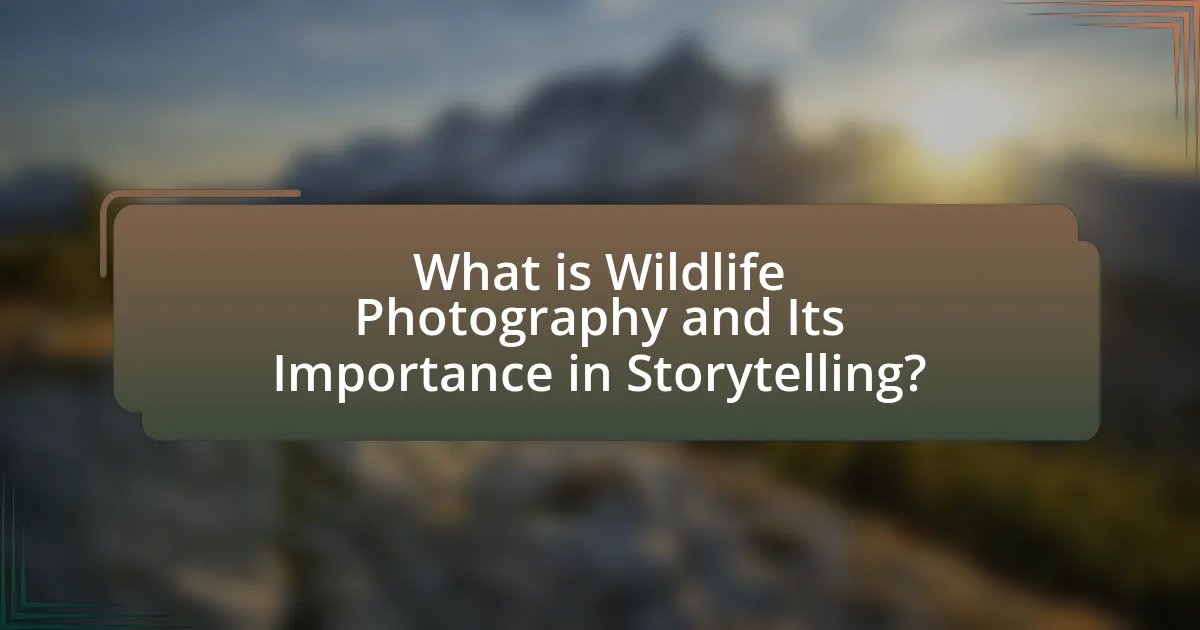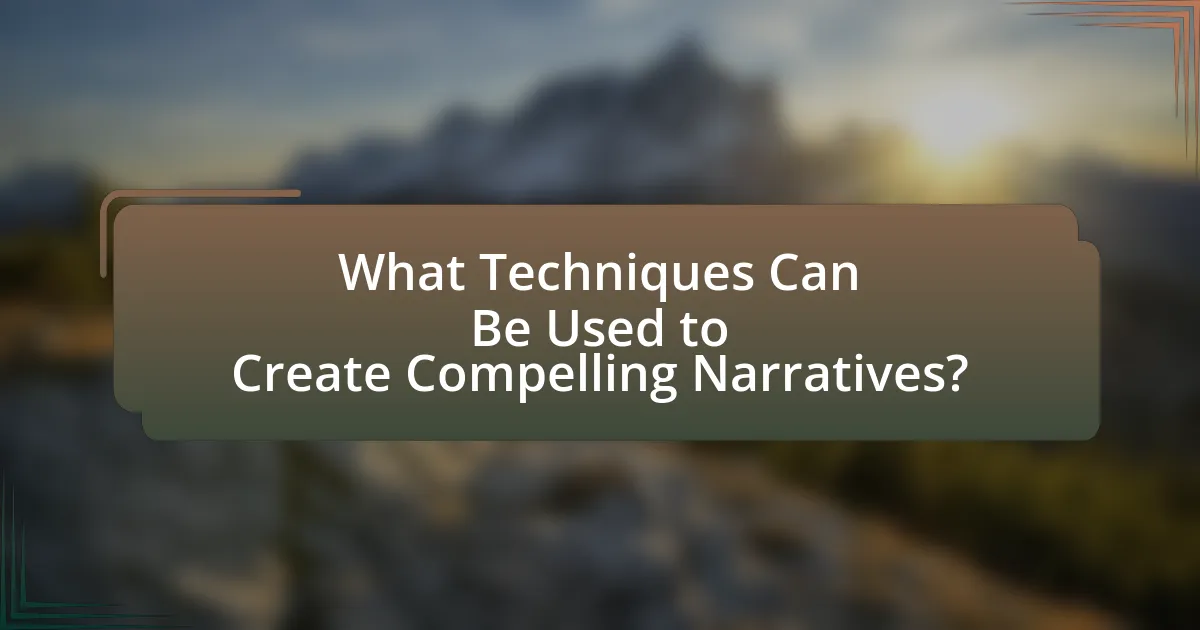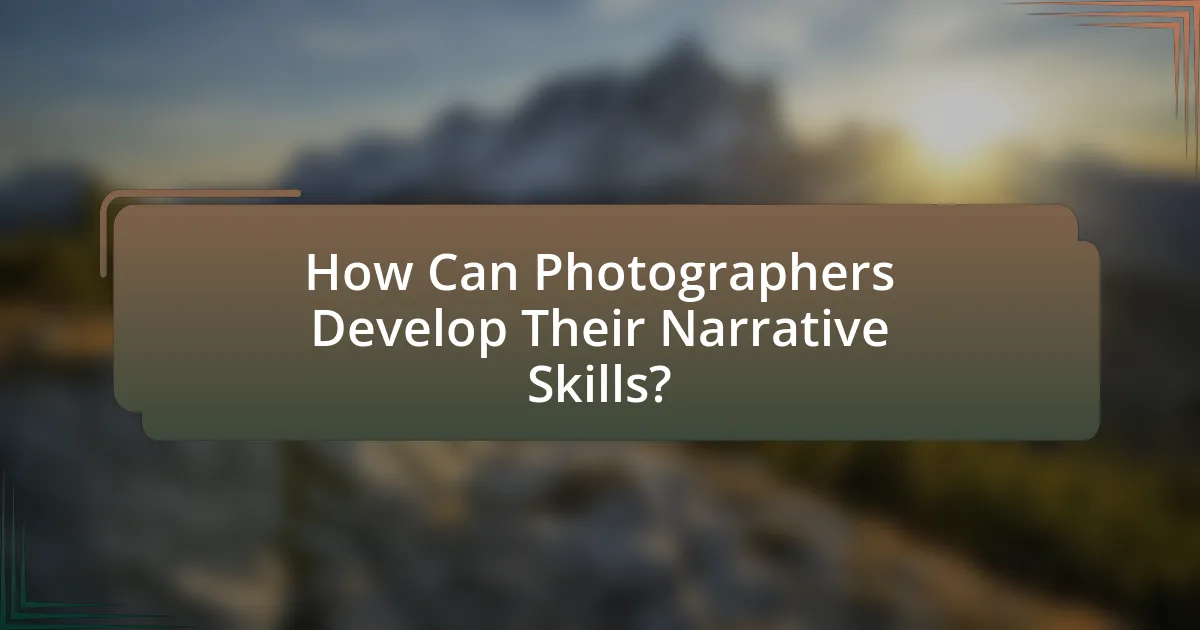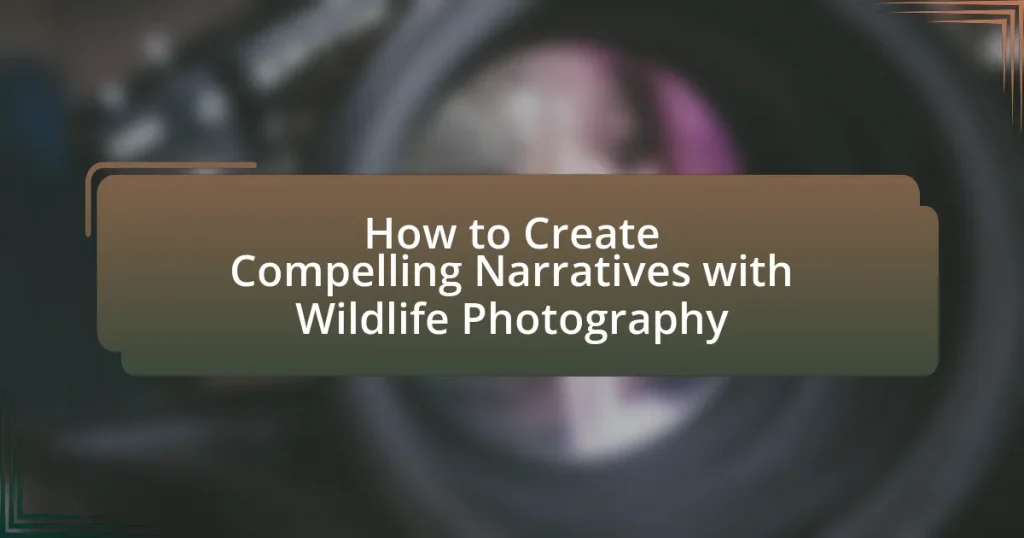Wildlife photography is a vital practice that captures animals in their natural habitats, emphasizing their behaviors and environments while contributing to storytelling and conservation efforts. This article explores the significance of narrative in wildlife photography, detailing how elements such as composition, lighting, and emotional resonance enhance the storytelling process. It discusses techniques for creating compelling narratives, the importance of context, and strategies to avoid common pitfalls, ultimately guiding photographers in developing their narrative skills to effectively engage viewers and raise awareness about ecological issues.

What is Wildlife Photography and Its Importance in Storytelling?
Wildlife photography is the practice of capturing images of animals in their natural habitats, emphasizing their behavior and environment. This genre of photography plays a crucial role in storytelling by conveying the beauty and complexity of wildlife, fostering a deeper understanding of ecological issues. For instance, impactful wildlife photographs can highlight the effects of climate change on animal populations, as seen in the work of renowned photographers like National Geographic’s Paul Nicklen, who documents the plight of polar bears. Such images not only evoke emotional responses but also inspire conservation efforts, demonstrating the power of visual storytelling in raising awareness and driving action.
How does wildlife photography contribute to narrative creation?
Wildlife photography contributes to narrative creation by visually capturing the behaviors, habitats, and interactions of animals, which helps convey stories about nature and conservation. This form of photography allows viewers to engage emotionally with the subject matter, fostering a deeper understanding of ecological relationships and the impact of human activity on wildlife. For instance, images of endangered species in their natural environments can highlight the urgency of conservation efforts, effectively communicating the narrative of survival and the need for protection. Studies have shown that compelling visual storytelling can increase awareness and inspire action, making wildlife photography a powerful tool in environmental advocacy.
What elements of wildlife photography enhance storytelling?
Elements of wildlife photography that enhance storytelling include composition, lighting, emotion, and context. Composition guides the viewer’s eye and creates a narrative flow, while lighting sets the mood and highlights key subjects. Emotion captures the viewer’s attention and fosters a connection, often achieved through close-ups or action shots. Context provides background information about the habitat or behavior, enriching the story by situating the subject within its environment. For instance, a photograph of a mother bear with her cubs in a natural setting conveys a deeper narrative about family dynamics in wildlife.
How can emotions be conveyed through wildlife images?
Emotions can be conveyed through wildlife images by capturing the expressions, behaviors, and environments of animals that resonate with human feelings. For instance, a photograph of a mother bear nurturing her cubs can evoke feelings of tenderness and protection, while an image of a lone wolf howling at the moon may elicit a sense of solitude and longing. The use of lighting, composition, and color also plays a crucial role; warm tones can create a sense of comfort, while stark contrasts can evoke drama or tension. Research indicates that viewers often project their emotions onto images based on visual cues, making the emotional impact of wildlife photography significant in storytelling.
Why is narrative important in wildlife photography?
Narrative is important in wildlife photography because it enhances the emotional connection between the viewer and the subject. A compelling narrative can transform a simple image into a story that evokes empathy, curiosity, and awareness about wildlife and their habitats. For instance, photographs that depict animals in their natural behaviors or interactions can illustrate the challenges they face, such as habitat loss or climate change, thereby raising awareness and prompting conservation efforts. Studies have shown that storytelling in visual media significantly increases audience engagement and retention of information, making narrative a crucial element in effectively communicating the significance of wildlife photography.
What role does context play in wildlife narratives?
Context plays a crucial role in wildlife narratives by providing the background and setting that shape the story being told. It influences how audiences perceive the behavior, habitat, and significance of wildlife, allowing for a deeper understanding of the species and their interactions with the environment. For instance, a narrative that includes the ecological context of a species, such as its role in the food chain or its adaptation to climate change, enhances the emotional and educational impact of the story. Research indicates that narratives enriched with contextual details lead to greater engagement and empathy from viewers, as they can relate the wildlife’s experiences to broader environmental issues.
How can a strong narrative impact viewer engagement?
A strong narrative significantly enhances viewer engagement by creating an emotional connection and providing context to the visual content. When viewers can relate to the story being told through wildlife photography, they are more likely to invest their attention and emotions in the images. Research indicates that narratives can increase memory retention by up to 65%, as they help viewers process information in a more meaningful way. This connection not only captivates the audience but also encourages them to share the content, further amplifying engagement.

What Techniques Can Be Used to Create Compelling Narratives?
Techniques to create compelling narratives in wildlife photography include using strong visual storytelling, incorporating emotional elements, and employing a clear structure. Strong visual storytelling captures the viewer’s attention through striking images that convey action, emotion, or a unique perspective of wildlife. Emotional elements, such as showcasing the struggles or triumphs of animals, resonate with audiences and foster a connection. A clear structure, often following a beginning, middle, and end format, helps guide the viewer through the narrative, making it more engaging and memorable. These techniques are supported by studies in visual communication, which indicate that narratives with emotional depth and structured storytelling significantly enhance viewer engagement and retention.
How can composition influence the narrative in wildlife photography?
Composition significantly influences the narrative in wildlife photography by determining how the subject is framed and perceived. Effective composition guides the viewer’s eye, highlights key elements, and establishes context, which collectively shape the story being told. For instance, the rule of thirds can create dynamic tension and draw attention to the animal’s behavior, while leading lines can guide the viewer through the scene, enhancing the narrative flow. Additionally, the use of negative space can evoke feelings of isolation or freedom, depending on the subject’s placement within the frame. Studies in visual perception indicate that well-composed images are more engaging and memorable, reinforcing the importance of composition in conveying a compelling narrative in wildlife photography.
What are the key compositional techniques for storytelling?
The key compositional techniques for storytelling include the use of framing, leading lines, the rule of thirds, and depth of field. Framing involves using elements within the scene to create a “frame” around the subject, drawing the viewer’s eye to the focal point. Leading lines guide the viewer’s gaze through the image, creating a sense of movement and direction. The rule of thirds suggests dividing the image into a grid and placing key elements along these lines or at their intersections to create balance and interest. Depth of field controls the focus in an image, allowing the subject to stand out against a blurred background, enhancing the narrative. These techniques are essential in wildlife photography to convey emotion and context effectively.
How does framing affect the viewer’s perception of the narrative?
Framing significantly influences the viewer’s perception of the narrative by directing attention and shaping interpretation. When a photograph is framed to emphasize certain elements, such as the subject’s environment or emotional expression, it can evoke specific feelings or thoughts in the viewer. For instance, a tight frame around a lion in a savannah can create a sense of intimacy and urgency, while a wide frame showing the lion in its habitat may evoke feelings of awe and respect for nature. Research by visual communication experts indicates that framing can alter the perceived importance of elements within an image, thereby affecting the overall narrative conveyed. This demonstrates that the way a scene is framed can fundamentally change how viewers engage with and understand the story being told through wildlife photography.
What role does lighting play in storytelling through wildlife photography?
Lighting plays a crucial role in storytelling through wildlife photography by influencing mood, highlighting subjects, and enhancing visual narratives. Proper lighting can evoke emotions, such as warmth during golden hour or drama during harsh midday sun, thereby shaping the viewer’s perception of the scene. For instance, backlighting can create silhouettes that emphasize the animal’s shape and movement, while soft, diffused light can reveal intricate details of fur or feathers, adding depth to the story being told. Studies in photography emphasize that the quality and direction of light can significantly alter the interpretation of an image, making it a vital element in conveying the intended message and emotion in wildlife photography.
How can different lighting conditions alter the mood of a photograph?
Different lighting conditions significantly alter the mood of a photograph by influencing the colors, shadows, and overall atmosphere. For instance, soft, diffused lighting, such as during golden hour, creates a warm and inviting mood, enhancing the emotional connection to the subject. In contrast, harsh lighting can produce stark shadows and high contrast, often evoking feelings of tension or drama. Research indicates that the color temperature of light affects emotional perception; warmer tones are associated with comfort and happiness, while cooler tones can convey sadness or detachment. Therefore, the choice of lighting is crucial in wildlife photography, as it directly impacts the viewer’s emotional response to the image.
What techniques can be used to manipulate light for narrative effect?
Techniques to manipulate light for narrative effect in wildlife photography include backlighting, sidelighting, and the use of reflectors. Backlighting creates silhouettes that emphasize shapes and forms, enhancing drama and mood. Sidelighting adds depth and texture, highlighting the details of the subject while creating shadows that can evoke emotion. Reflectors can redirect light to illuminate specific areas, drawing attention to key elements in the composition. These techniques are supported by the principles of photography, where light direction and quality significantly influence the viewer’s perception and emotional response to the image.

How Can Photographers Develop Their Narrative Skills?
Photographers can develop their narrative skills by actively studying storytelling techniques and applying them to their visual work. Engaging with literature on narrative structure, such as Joseph Campbell’s “The Hero with a Thousand Faces,” can provide insights into character development and plot progression, which are essential for creating compelling stories through images. Additionally, practicing composition techniques, such as the rule of thirds and leading lines, helps in guiding the viewer’s eye and enhancing the narrative flow within a photograph.
Furthermore, analyzing the work of renowned wildlife photographers, such as National Geographic’s Joel Sartore, reveals how they capture moments that convey emotion and context, thereby enriching the narrative. Participating in workshops or critique groups can also provide valuable feedback, allowing photographers to refine their storytelling abilities through peer review and discussion.
What practices can help photographers improve their storytelling abilities?
Photographers can improve their storytelling abilities by focusing on composition, understanding their subjects, and utilizing light effectively. Composition guides the viewer’s eye and can convey emotions or themes; for instance, the rule of thirds can create dynamic images that draw attention to the subject. Understanding subjects, particularly in wildlife photography, allows photographers to capture behaviors and interactions that tell a deeper story, as seen in studies highlighting the importance of context in visual narratives. Utilizing light effectively, such as shooting during golden hours, enhances mood and atmosphere, which can significantly impact the narrative quality of an image.
How can studying other photographers enhance narrative skills?
Studying other photographers enhances narrative skills by exposing individuals to diverse storytelling techniques and visual styles. By analyzing the composition, lighting, and subject matter used by various photographers, one can learn how to effectively convey emotions and messages through imagery. For instance, examining the work of renowned wildlife photographers like National Geographic’s Joel Sartore reveals how he captures the essence of endangered species, thereby telling a compelling story about conservation. This analysis helps photographers understand the importance of context, framing, and timing in creating impactful narratives, ultimately improving their own storytelling abilities in wildlife photography.
What exercises can photographers undertake to practice narrative creation?
Photographers can undertake exercises such as creating a photo story, developing a series of images that convey a specific theme, and practicing visual storytelling techniques to enhance narrative creation. For instance, a photo story can involve capturing a sequence of events in wildlife behavior, which helps in understanding how to build a narrative arc. Additionally, photographers can experiment with different perspectives and compositions to convey emotions and context, thereby enriching the narrative. Engaging in these exercises allows photographers to refine their ability to tell compelling stories through their images, as evidenced by successful wildlife photographers who often utilize these methods to connect with their audience.
What are common pitfalls to avoid in wildlife photography narratives?
Common pitfalls to avoid in wildlife photography narratives include anthropomorphism, lack of context, and overemphasis on technical details. Anthropomorphism occurs when photographers attribute human emotions or intentions to animals, which can mislead audiences about animal behavior. Lack of context can result in narratives that fail to explain the significance of the wildlife being photographed, diminishing the impact of the story. Overemphasis on technical details, such as camera settings, can distract from the narrative itself, making it less engaging for viewers. These pitfalls can undermine the effectiveness of wildlife photography in conveying meaningful stories about nature.
How can clichés undermine the effectiveness of a narrative?
Clichés undermine the effectiveness of a narrative by making it predictable and unoriginal. When narratives rely on overused phrases or ideas, they fail to engage the audience, as these familiar elements do not evoke strong emotions or provoke thought. For instance, in wildlife photography, using clichés like “circle of life” can detract from the unique story behind a specific animal or ecosystem, leading to a lack of connection with the viewer. This diminishes the narrative’s impact, as originality is crucial for capturing attention and fostering a deeper understanding of the subject matter.
What strategies can be employed to maintain originality in storytelling?
To maintain originality in storytelling, one effective strategy is to draw from personal experiences and unique perspectives. By incorporating individual insights and emotions, storytellers can create narratives that resonate authentically with audiences. Research indicates that personal storytelling enhances engagement, as seen in studies by the University of Southern California, which found that stories rooted in personal experience are more memorable and impactful. Additionally, blending diverse influences, such as different cultures or art forms, can foster originality by introducing fresh ideas and themes. This approach not only enriches the narrative but also broadens its appeal, as evidenced by the success of cross-genre works in literature and film.
What are some practical tips for creating compelling narratives with wildlife photography?
To create compelling narratives with wildlife photography, focus on capturing the behavior and emotions of animals in their natural habitats. This approach allows viewers to connect with the subject on a deeper level, fostering empathy and understanding. For instance, photographing a mother bear with her cubs can evoke feelings of tenderness and protection, while an image of a lion hunting can convey the raw power of nature. Additionally, using varied perspectives and compositions enhances storytelling; wide shots can establish context, while close-ups can highlight intricate details. Incorporating elements like light and shadow can also add drama and mood to the images. Research indicates that storytelling in photography significantly increases viewer engagement, making it essential for wildlife photographers to master these techniques.
